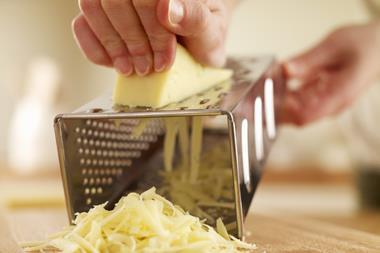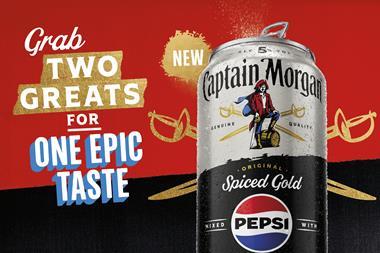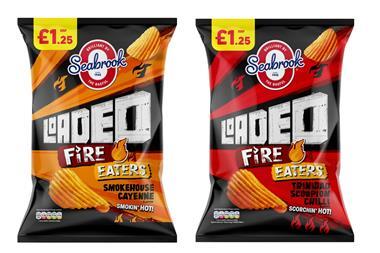Something old, something new, something borrowed and something blue the key ingredients for a successful marriage with your cheese category. It's all about striking a balance between the old faithful Cheddars, exciting npd, something special from our Continental cousins and, of course, a stilton.
As far as npd goes, flavours appear to be big news, with the launch of Bel UK's Laughing Cow Deli-Light range. Bel UK marketing director Ian Greengrass says: "Consumers tell us that sometimes they find plain cheese can be a little boring. The new products aim to offer consumers more variety with flavours including blue cheese, onion and goat's cheese."
Also taking this line is Bradbury & Son with the latest addition to its edam range, Go Red Hot Dutch. "Additive cheese is a good way of increasing consumer usage and consumption," says sales and marketing director Chris Chisnall. "Cranberry and apricot cheeses are common, but there's a wide range of savoury additives, such as pepper and chilli, that are growing in popularity."
But don't let the promise of niche areas, such as flavours, divert you from the main attraction, warns Dairy Crest. "Anything that drives category value and generates interest in the fixture is good," says customer marketing manager Will Pritchard. "However, it is also important not to be distracted by the fact that everyday block cheese remains the key segment across convenience, accounting for 58% of total cheese value sales (52 weeks ending January 24, 2010) and that Cheddar is the only real everyday cheese."
With Dairy Crest's £205m Cathedral City brand as the number-one Cheddar in the convenience sector, he knows what he's talking about. And his advice to retailers on the future of the category? "Convenience retailers should focus on providing consumers with greater choice and offering points of difference, such as focusing on lighter variants in light of the ongoing FSA saturated fat campaign," he says.
Last December the FSA put forward proposals for businesses to develop and promote reduced fat varieties to grow the reduced fat submarket from less than 10% to more than 25% of the Cheddar market by 2015. Dairy Crest has already seen success with its Cathedral City Mature Lighter brand and, following the FSA's advice, others look set to follow suit.
Another company seeking success with low-fat cheese is Wyke Farms. Initially, its Leskol Half Fat cheese was kept separate from the Wyke range and marketed as a health food. Then in 2008 its pack was redesigned with the brand's farm-style logo.
While the redesign gave Leskol all the quality and provenance associated with a Wyke Farms product, it somewhat diluted the brand's identity as a cheese for people on a special diet. Managing director Richard Clothier is keen to explain to both consumers and retailers exactly what the product is all about. "The biggest problem for us is conveying what makes Leskol special," he says. "Cathedral City Mature Lighter contains 14.9g saturated fat and is for people who want a healthier lifestyle, whereas Leskol contains just 1.3g of sat fats and may be more suitable for people who are on specialised diets to keep their saturated fat down, for example diabetics, or people needing to lower their cholesterol."
Overcoming misperceptions has also been an issue for Bel UK's Leerdammer brand, which it tackled head-on earlier this year with a light-hearted, yet impactful advert. "Consumer research highlighted that before trying Leerdammer, some consumers thought it would be too mild. However, once they tried it they really enjoyed it," says Greengrass. "As such, the TV campaign aimed to communicate the 'not as mild as you might think' message."
To add weight to its claim that Leerdammer is a flavoursome product, it also launched a mature variant. "Leerdammer Mature responds to the current consumer demand for stronger tastes," says Greengrass.
Kraft Foods is another company that has invested in marketing to alter consumers' preconceived ideas. Its Dairylea brand has come under fire in the past, with the Advertising Standards Authority banning a Lunchables ad in 2007, and the British Heart Foundation accusing Dairylea of "misleading" parents in 2008. So for Dairylea, reassuring parents is the name of the game.
The brand's latest bout of advertising informs consumers of a reformulated ingredients list with improved creaminess. "'No artificial colours, flavours or preservatives added' and 'great new taste' messages are highlighted on pack to help mums feel good about what they're buying for their kids," says Steve Mounty, director of convenience and distributive at Kraft Foods UK.
Philadelphia is also taking an emotive stance with its latest advertising run, which encourages consumers to 'love it'. Following last year's high-profile relaunch, Philly returned to the small screen in February. "The TV advertising shows how creative cooks can use Philadelphia as an ingredient in their favourite recipes," says Mounty. "We're taking Philadelphia beyond a bread spread and deeper into the realms of cookery."
The concept of increasing sales by introducing new recipes and consumption occasions is something that many c-stores can adopt. "There are all sorts of carriers for cheese that could be used to stimulate added value purchases not just normal bread and crackers, but also pasta, potatoes and any recipes that includes cheese as an ingredient," says Craig Brooks, marketing director at Kavli.
"Shoppers are looking for meal solutions, so if retailers can offer inspiration and maybe a saving on a joint purchase as well, then sales will be boosted."
Chisnall agrees, claiming that UK consumers have a fairly limited scope when it comes to cheese consumption. "Retailers need to get people thinking outside the box in terms of flavour combinations. For example, you could have pos suggesting consumers make a Cheddar and chilli toastie, or a stilton sauce with milk and butter."
He also states that there is an opportunity for retailers to convince consumers to buy into cheeses a little more adventurous than Cheddar by offering a cheeseboard deal. "They could provide a Cheddar, stilton, an additive cheese, a soft cheese, and a couple of continentals, and then offer shoppers their pick of four for a set price."
Kerrygold sales and marketing director Sean Whitfield supports the notion that c-stores can afford to go beyond Cheddar. "Retailers will see the benefit of stocking a wider breadth of products, including speciality lines, if communication of the range on offer is clearly signposted," he says.
Stéphane Plessis, European export manager for Isigny Sainte-Mère, couldn't agree more. He claims that retailers can offer consumers a point of difference by stocking up on premium speciality cheeses, such as Isigny's AOC Camembert. Displaying such cheeses next to complementary beverages can also work wonders for sales. "Convenience retailers could display premium cheeses in the chiller alongside selected wines," he suggests.
In addition, retailers could make appropriate recommendations for complementary cheese and wines, claims Chisnall.
Indeed, anything that makes people's shopping experience more personal is a winner. Harry Tuffins has the right idea the retailer has been working with Joseph Heler Cheese to come up with its own cheese packaging.
While Cheddar will remain the big cheese for the foreseeable future, it doesn't mean it has to be your sole offering. Says Chisnall: "More than 90% of households always buy Cheddar, but they can be persuaded to buy something else once they're in a store. Retailers need to get their fair share of sales by expanding into other cheeses."
As far as npd goes, flavours appear to be big news, with the launch of Bel UK's Laughing Cow Deli-Light range. Bel UK marketing director Ian Greengrass says: "Consumers tell us that sometimes they find plain cheese can be a little boring. The new products aim to offer consumers more variety with flavours including blue cheese, onion and goat's cheese."
Also taking this line is Bradbury & Son with the latest addition to its edam range, Go Red Hot Dutch. "Additive cheese is a good way of increasing consumer usage and consumption," says sales and marketing director Chris Chisnall. "Cranberry and apricot cheeses are common, but there's a wide range of savoury additives, such as pepper and chilli, that are growing in popularity."
But don't let the promise of niche areas, such as flavours, divert you from the main attraction, warns Dairy Crest. "Anything that drives category value and generates interest in the fixture is good," says customer marketing manager Will Pritchard. "However, it is also important not to be distracted by the fact that everyday block cheese remains the key segment across convenience, accounting for 58% of total cheese value sales (52 weeks ending January 24, 2010) and that Cheddar is the only real everyday cheese."
With Dairy Crest's £205m Cathedral City brand as the number-one Cheddar in the convenience sector, he knows what he's talking about. And his advice to retailers on the future of the category? "Convenience retailers should focus on providing consumers with greater choice and offering points of difference, such as focusing on lighter variants in light of the ongoing FSA saturated fat campaign," he says.
Last December the FSA put forward proposals for businesses to develop and promote reduced fat varieties to grow the reduced fat submarket from less than 10% to more than 25% of the Cheddar market by 2015. Dairy Crest has already seen success with its Cathedral City Mature Lighter brand and, following the FSA's advice, others look set to follow suit.
ones to watch...
Light ideas
Dairy Crest's Cathedral City Mature Lighter is running a campaign with Macmillan Cancer Support. Its Lighten Up guide is free to access from the brand's website, and Dairy Crest will donate 50p to Macmillan for every download. tel: 01372 472200
Cream of the crop
A recipe reformulation means Dairylea tastes even creamier and cheesier, says manufacturer Kraft. The brand will be supported by a £4.7m marketing investment in 2010, including TV, online and pos. Kraft is giving away 100,000 packs on its website. tel: 01242 236101
Extra! Extra!
Cathedral City Mature has introduced a 200g + 50% Extra Free block into the convenience and wholesale trade. Cathedral City is worth £15m in the sector and is the number one cheese brand, according to Kantar. tel: 01372 472200
Wake up to Wyke Wyke Farms is back on TV this month with an ad focusing on provenance. It will also be sampling at shows and country fairs. To go greener Wyke is installing a new machine to make outer boxes with 20% less packaging. tel: 01749 813614
Kiwi influence
Bradbury & Son has launched a New Zealand Hawkes Bay mature Cheddar, which has been matured for between 18 months and two years. It is also in talks with Dutch beer Grolsch over a link-up to encourage purchase of its 'Old Amsterdam' Gouda. tel: 01298 23180
Light ideas
Dairy Crest's Cathedral City Mature Lighter is running a campaign with Macmillan Cancer Support. Its Lighten Up guide is free to access from the brand's website, and Dairy Crest will donate 50p to Macmillan for every download. tel: 01372 472200
Cream of the crop
A recipe reformulation means Dairylea tastes even creamier and cheesier, says manufacturer Kraft. The brand will be supported by a £4.7m marketing investment in 2010, including TV, online and pos. Kraft is giving away 100,000 packs on its website. tel: 01242 236101
Extra! Extra!
Cathedral City Mature has introduced a 200g + 50% Extra Free block into the convenience and wholesale trade. Cathedral City is worth £15m in the sector and is the number one cheese brand, according to Kantar. tel: 01372 472200
Wake up to Wyke Wyke Farms is back on TV this month with an ad focusing on provenance. It will also be sampling at shows and country fairs. To go greener Wyke is installing a new machine to make outer boxes with 20% less packaging. tel: 01749 813614
Kiwi influence
Bradbury & Son has launched a New Zealand Hawkes Bay mature Cheddar, which has been matured for between 18 months and two years. It is also in talks with Dutch beer Grolsch over a link-up to encourage purchase of its 'Old Amsterdam' Gouda. tel: 01298 23180
Another company seeking success with low-fat cheese is Wyke Farms. Initially, its Leskol Half Fat cheese was kept separate from the Wyke range and marketed as a health food. Then in 2008 its pack was redesigned with the brand's farm-style logo.
While the redesign gave Leskol all the quality and provenance associated with a Wyke Farms product, it somewhat diluted the brand's identity as a cheese for people on a special diet. Managing director Richard Clothier is keen to explain to both consumers and retailers exactly what the product is all about. "The biggest problem for us is conveying what makes Leskol special," he says. "Cathedral City Mature Lighter contains 14.9g saturated fat and is for people who want a healthier lifestyle, whereas Leskol contains just 1.3g of sat fats and may be more suitable for people who are on specialised diets to keep their saturated fat down, for example diabetics, or people needing to lower their cholesterol."
Overcoming misperceptions has also been an issue for Bel UK's Leerdammer brand, which it tackled head-on earlier this year with a light-hearted, yet impactful advert. "Consumer research highlighted that before trying Leerdammer, some consumers thought it would be too mild. However, once they tried it they really enjoyed it," says Greengrass. "As such, the TV campaign aimed to communicate the 'not as mild as you might think' message."
To add weight to its claim that Leerdammer is a flavoursome product, it also launched a mature variant. "Leerdammer Mature responds to the current consumer demand for stronger tastes," says Greengrass.
Kraft Foods is another company that has invested in marketing to alter consumers' preconceived ideas. Its Dairylea brand has come under fire in the past, with the Advertising Standards Authority banning a Lunchables ad in 2007, and the British Heart Foundation accusing Dairylea of "misleading" parents in 2008. So for Dairylea, reassuring parents is the name of the game.
The brand's latest bout of advertising informs consumers of a reformulated ingredients list with improved creaminess. "'No artificial colours, flavours or preservatives added' and 'great new taste' messages are highlighted on pack to help mums feel good about what they're buying for their kids," says Steve Mounty, director of convenience and distributive at Kraft Foods UK.
Philadelphia is also taking an emotive stance with its latest advertising run, which encourages consumers to 'love it'. Following last year's high-profile relaunch, Philly returned to the small screen in February. "The TV advertising shows how creative cooks can use Philadelphia as an ingredient in their favourite recipes," says Mounty. "We're taking Philadelphia beyond a bread spread and deeper into the realms of cookery."
The concept of increasing sales by introducing new recipes and consumption occasions is something that many c-stores can adopt. "There are all sorts of carriers for cheese that could be used to stimulate added value purchases not just normal bread and crackers, but also pasta, potatoes and any recipes that includes cheese as an ingredient," says Craig Brooks, marketing director at Kavli.
"Shoppers are looking for meal solutions, so if retailers can offer inspiration and maybe a saving on a joint purchase as well, then sales will be boosted."
Chisnall agrees, claiming that UK consumers have a fairly limited scope when it comes to cheese consumption. "Retailers need to get people thinking outside the box in terms of flavour combinations. For example, you could have pos suggesting consumers make a Cheddar and chilli toastie, or a stilton sauce with milk and butter."
He also states that there is an opportunity for retailers to convince consumers to buy into cheeses a little more adventurous than Cheddar by offering a cheeseboard deal. "They could provide a Cheddar, stilton, an additive cheese, a soft cheese, and a couple of continentals, and then offer shoppers their pick of four for a set price."
Kerrygold sales and marketing director Sean Whitfield supports the notion that c-stores can afford to go beyond Cheddar. "Retailers will see the benefit of stocking a wider breadth of products, including speciality lines, if communication of the range on offer is clearly signposted," he says.
Stéphane Plessis, European export manager for Isigny Sainte-Mère, couldn't agree more. He claims that retailers can offer consumers a point of difference by stocking up on premium speciality cheeses, such as Isigny's AOC Camembert. Displaying such cheeses next to complementary beverages can also work wonders for sales. "Convenience retailers could display premium cheeses in the chiller alongside selected wines," he suggests.
In addition, retailers could make appropriate recommendations for complementary cheese and wines, claims Chisnall.
Indeed, anything that makes people's shopping experience more personal is a winner. Harry Tuffins has the right idea the retailer has been working with Joseph Heler Cheese to come up with its own cheese packaging.
While Cheddar will remain the big cheese for the foreseeable future, it doesn't mean it has to be your sole offering. Says Chisnall: "More than 90% of households always buy Cheddar, but they can be persuaded to buy something else once they're in a store. Retailers need to get their fair share of sales by expanding into other cheeses."
top tips
Don't just stick to Cheddar - Retailers should stock a mixture of staple cheeses such as British Cheddars and territorial cheeses
Think big with promos - Consumers tend to opt for smaller formats in the convenience channel, however a few large packs sold on promotion will appeal to shoppers with the family in mind, and in turn drive interest in the fixture
Stick together - Consumer insight has shown that consumers want an easy-to-navigate fixture, with all cheese products sited together, not separated with other dairy products in between
Make use of multi-buysMulti-buy promotions particularly '2 for £X' work well as they allow consumers to expand their repertoire in cheese types and formats.
Source: Kerrygold
Don't just stick to Cheddar - Retailers should stock a mixture of staple cheeses such as British Cheddars and territorial cheeses
Think big with promos - Consumers tend to opt for smaller formats in the convenience channel, however a few large packs sold on promotion will appeal to shoppers with the family in mind, and in turn drive interest in the fixture
Stick together - Consumer insight has shown that consumers want an easy-to-navigate fixture, with all cheese products sited together, not separated with other dairy products in between
Make use of multi-buysMulti-buy promotions particularly '2 for £X' work well as they allow consumers to expand their repertoire in cheese types and formats.
Source: Kerrygold



























No comments yet